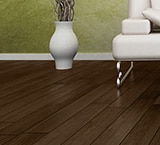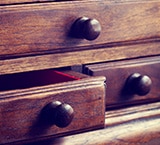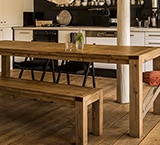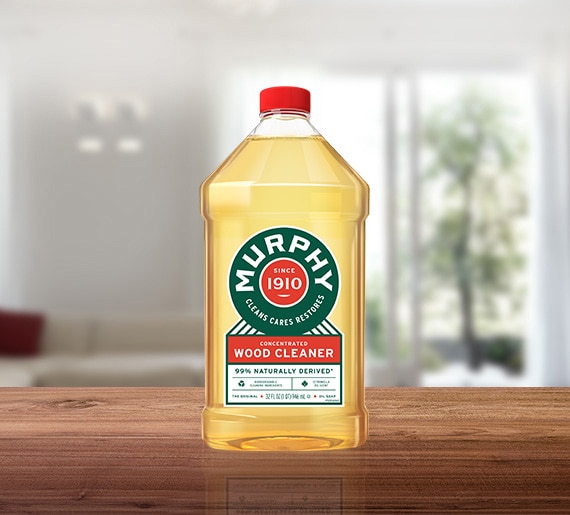HARDWOOD FLOORS & FLOORING
Hardwood Floor Scratch Repair: Five Tips for Getting Flawless Floors

Hardwood floors are a gorgeous addition to any home, but now and then, they need a little maintenance. It's always nice to have a few tricks up your sleeve when facing those small scratches left behind from everyday living. Minor hardwood floor scratch repair is fairly easy for avid do-it-yourselfers; it's those bigger gouges that can be difficult without the right experience.
SOLID VS. ENGINEERED HARDWOOD
It is important to know what type of flooring you have when it comes to DIY repair, particularly with intensive fixes. Do you know whether you have Solid Or Engineered Hardwood Floors? If not, you will need to find an area of exposed hardwood. The key difference is solid hardwood will have one solid layer, whereas engineered hardwood involves sandwiched layers of plywood and manufactured wood topped with a thin sheet of hardwood. Look at the outer, unfinished edges of a plank to determine which kind of flooring you have installed.
FLOOR INSPECTION AND PREPARATION
Once you know what kind of flooring material you're dealing with, it's time to examine the damage you need to repair. Minor scratches and small gouges can be resolved by simple hardwood scratch repair tactics. But, more extensive damage will need to be treated by a combination of screening, sanding and resurfacing or even replacing the flooring. With smaller repairs, prepare your surface beforehand by cleaning it with a wood soap like Murphy® Original Wood Cleaner.
SIMPLE HARDWOOD REPAIR
Markers and stains, natural solutions and fillers are some of the easiest solutions for hardwood floor scratch repair. Light and subtle scratches can easily be filled in with matching floor markers and stains. The idea here is to fill in the scratch, so that the exposed wood doesn't stand out. For a natural solution for lighter colored wood floors, try raw walnut and rubbing the walnut meal into the scratches. Other notable solutions include equal parts lemon juice and vegetable oil or vinegar and olive oil to mask scratches. Lastly, if you have small nicks, holes or gouges a wood filler product will do the trick. They are easy to use and can be stained to match the flooring as well.
INTERMEDIATE HARDWOOD REPAIR
Deeper hardwood scratches are more difficult and require more experience and understanding of flooring repair concepts. Common methods include screening, resurfacing and replacing. If your flooring is riddled with light, shallow scratches, screening could be a solution, but only if your floors have never been waxed. How can you tell if your floor has a waxed finish? Dampen a cloth with some paint thinner. Choose a small, discreet area of the floor and wipe the area with the cloth. If the floor has been coated with wax, the existing finish will wipe off.
Once you have determined there is no wax finish, use a floor polish as a sander to remove the top polyurethane finish, and then the floor is refinished with a fresh coat of polyurethane. If your floor has wax, it is possible to remove it and then screen the floor, but this is best left to a professional because any leftover wax will ruin your finish.
If screening is not an option, resurfacing is the next possible solution. This repair is not typically recommended for engineered wood; if you sand engineered wood too much, you can damage the boards, making them irreparable. This is especially true if you do not know the history of your flooring or if it has been resurfaced in the past. To resurface wood flooring, you begin by using a drum sander to sand the existing floor down to the bare wood while maintaining an even level of the floor surface. Next, you apply a suitable stain and finally a polyurethane coat to finish. For more detailed information on this process, take a look at This Old House's guide to refinishing wood floors.
The last option, when all else fails, is replacement. Sometimes, wood becomes so damaged and warped that repair is simply not an option, and a partial or complete replacement becomes necessary. This often is the case with severely damaged engineered wood, wherein the thin layer of wood is too thin for resurfacing.
WHEN TO GET PROFESSIONAL HELP
Sometimes, hardwood floor scratch repair is best left to the professionals. Some specialty woods, like maple, and engineered hardwood need more experience to be repaired properly without destroying the flooring. Nonetheless, consider the degree of repair and the material before proceeding with any DIY job. Calling a professional is often better than taking a "crack" at it without the proper expertise.
This article was brought to you by Colgate-Palmolive Company, the makers of Murphy® Oil Soap. The views and opinions expressed by the author do not reflect the position of the Colgate-Palmolive Company.









